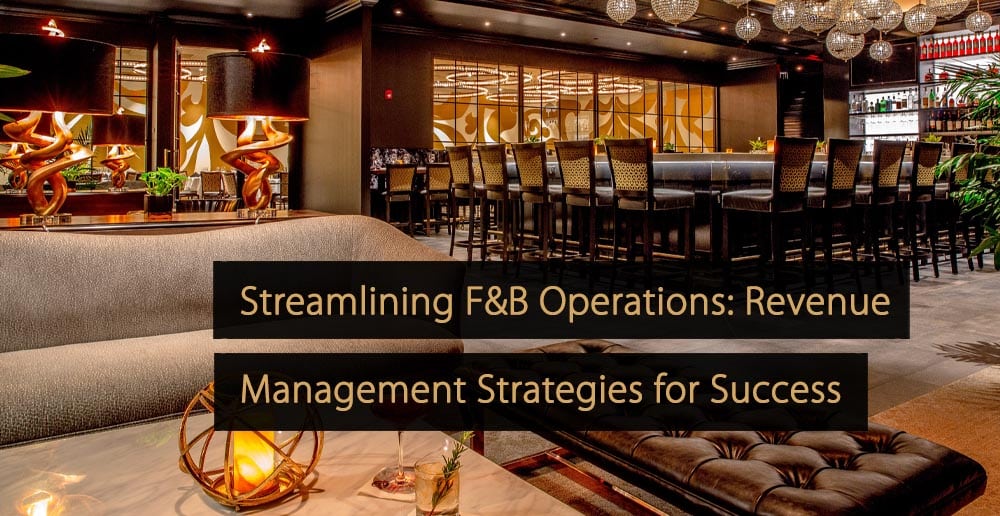In today’s competitive landscape, optimizing revenue and maximizing profitability is crucial for success in the food and beverage (F&B) industry. F&B establishments need to implement effective revenue management strategies to achieve these goals.
Streamlining F&B Operations
Businesses can streamline their operations and enhance their financial performance by adopting a systematic approach to pricing, inventory management, and customer segmentation.
In this article, you will discover the key revenue management techniques and strategies and their impact on F&B establishments.
1. Understanding F&B Revenue Management
Understanding revenue management is necessary for F&B establishments aiming to maximize their revenue and profitability. It encompasses strategic control and manipulation of pricing and inventory to achieve optimal results. By delving into consumer behavior, market demand, and operational costs, businesses can make informed, data-driven decisions that positively impact their pricing strategies and overall operational efficiency.
- Analyzing Consumer Behavior: Revenue management starts by gaining insights into consumer behavior. By understanding their target customers’ preferences, spending patterns, and purchasing habits, F&B establishments can tailor their pricing strategies accordingly. This analysis allows businesses to identify price sensitivity, demand fluctuations, and customer preferences for different offerings.
- Assessing Market Demand: Revenue management closely monitors and analyzes market demand. Businesses can adjust their pricing strategies by studying market trends, competitor activities, and customer expectations to align with the current demand landscape. This includes identifying peak periods, understanding seasonal variations, and responding proactively to changes in market dynamics.
- Optimizing Pricing Strategies: Effective revenue management relies on optimizing pricing strategies to maximize revenue potential. This involves setting prices that balance customer willingness to pay and operational costs. F&B establishments must consider factors such as ingredient costs, labor expenses, overheads, and desired profit margins. Businesses can leverage market research, customer segmentation, and data analysis to optimize revenue streams by establishing pricing tiers, dynamic pricing models, or value-added pricing strategies.
- Streamlining Operations: Revenue management also aims to streamline operational processes. By aligning pricing and inventory management, businesses can ensure efficient resource allocation. This includes adjusting inventory levels based on demand forecasts, reducing waste, minimizing stockouts, and optimizing procurement practices. Efficient operations lead to cost savings, increased productivity, and improved profitability.
- Data-Driven Decision Making: Revenue management relies on robust data analysis. By leveraging data from various sources, such as sales records, customer feedback, online reviews, and market trends, F&B establishments can make informed decisions. Advanced analytics tools can provide valuable insights into customer preferences, menus, key performance indicators, pricing elasticity, and revenue patterns. These insights enable businesses to fine-tune their revenue management tips, identify opportunities for improvement, and stay ahead of the competition.
2. Setting the Stage for Data Collection
As mentioned above, collecting information regarding your restaurant’s guests and operations is the first step in developing a successful revenue management strategy. Operators can create a comprehensive, consolidated, and usable database using technologies like your reservation and online ordering platforms, CRM, POS, and email service provider.
Start your data collection with these 8 essential data points:
- No-show and cancellation rate
- Estimate of customer wait times
- Number of covers over time or daily
- The average party size bookings
- Table turnover times
- Guest preferences
- The number of bookings per online channel
- Overall guest feedback
Establishing a solid foundation with data collection and working your way up can help you efficiently optimize your total revenue made from your restaurant and hotel guests.
3. Investing in Reservation and Table Management Tools
Managing reservations and table allocations with hospitality platforms like Eat App is crucial for optimizing seating capacity and customer flow. Implementing a comprehensive reservation and table management system enables F&B establishments to evaluate flexible seating options to balance customer preferences, table utilization, and operational efficiency. By tracking customer arrival times, managing waitlists, and optimizing table turnarounds, businesses can maximize seating capacity, minimize wait times, and improve overall customer experience.
Investing in reservation systems and table management tools is a smart strategy for F&B establishments looking to streamline operations and enhance the customer experience.
4. Optimizing Your Booking Channels
There are now more options than ever for diners to make a restaurant reservation, including in-person, over the phone, online, and through third-party and direct booking systems. Each channel has restaurant costs, such as administrative labor, commissions, and software licenses. Operators must ensure that these channels are functional for them.
To help you understand more about channels and if they’re producing results, ask yourself the following questions:
- How much does acquiring a new customer cost through various channels cost?
- What are the differences in lifetime guest value per channel?
- Does the distribution of bookings throughout these channels serve your goals?
- What kind of customer information is available to you through each booking channel?
Now, let’s take a look at the top three ways to optimize your booking channels:
Giving Direct Online Booking Channels Top Priority
Encourage visitors to use the most efficient booking options. Use your website, Google My Business directory, and social media accounts to activate direct bookings to your online reservation widget and pay no additional commission fees.
Reducing the Number of Small-Capacity Tables
During busy times, increase table capacity. Rearrange your reservation book to prevent smaller parties from occupying larger tables during the meal period or before primetime to avoid under-selling.
Making Visitors Feel Engaged
No-shows result in lost revenue and a negative experience for guests and staff. Asking visitors to put their cards on file or encouraging guests to pay a reservation deposit will help you avoid surprises during busy times. When visitors are genuinely interested in their reservations, they are more likely to confirm their attendance or cancel within the grace period for refunds, providing you enough room revenue and time to refill those tables.
5. Reviewing Dynamic Pricing
Dynamic pricing is a key revenue management strategy that can help F&B businesses optimize their pricing strategy and improve profitability. By adjusting prices in real-time based on demand and other factors, businesses can capture maximum revenue during peak periods and encourage sales during slower times.
One of the key benefits of dynamic pricing is the ability to respond quickly to market changes. For example, if a competitor lowers prices or unexpected events impact demand, businesses can adjust their pricing strategy to remain competitive and maximize revenue. This flexibility is particularly important in the F&B and hospitality industry, where demand can fluctuate rapidly due to weather, events, and seasonal trends.
By leveraging technology solutions such as automated pricing tools, businesses can implement dynamic pricing in a more efficient and effective way. These tools use algorithms and data analysis to adjust prices based on demand, time of day, seasonality, and other factors. This allows businesses to optimize prices in real time without the need for manual intervention.
Dynamic pricing can also help businesses optimize their inventory and menu offerings. By adjusting prices based on demand, or rising cost, businesses can encourage customers to purchase certain items or opt for higher-margin offerings. This can help hospitality businesses improve profitability and maximize revenue.
6. Taking a Look at Menu Engineering
Looking at Menu engineering is another crucial aspect of revenue management for F&B establishments. Menu engineering involves strategically designing and pricing menu items to maximize profitability. By analyzing the popularity and profitability of dishes, businesses, and restaurant managers can make informed decisions about which items to promote, modify, or eliminate.
Data analytics and customer feedback play a vital role in menu engineering. By leveraging these insights, establishments can identify top-selling items and high-margin dishes contribute significantly to revenue. This information helps determine which menu items should be more prominent or highlighted as “chef’s recommendations.”
In addition, menu engineering involves adjusting portion sizes, adding or removing ingredients, and aligning pricing with perceived value. Cost-effective ingredient substitutions or bundling items together can increase the profitability of menu items to create value-driven meal options. Conversely, underperforming or eliminating menu items that can be reevaluated or replaced to optimize revenue potential.
By implementing menu engineering competitive price shop strategies, F&B establishments can increase profitability, drive revenue growth, and improve customer satisfaction. A well-designed and strategically priced menu ensures that the most profitable items receive the necessary attention while aligning menu prices with customer preferences and expectations. An essential revenue management technique allows businesses to optimize their menu offerings and maximize their financial success.
7. Demanding Forecasting
Accurate demand forecasting is critical to successful revenue management in the F&B industry. By leveraging historical data, seasonality patterns, and market trends, establishments can predict demand fluctuations and make informed decisions to optimize their operations. Implementing demand forecasting tools enables businesses to maintain optimal inventory levels, minimize waste, and avoid stockouts, ensuring that resources are allocated efficiently while meeting customer demand.
This strategic approach helps F&B establishments streamline their supply chain, reduce carrying costs, and enhance customer satisfaction by ensuring the availability of desired products or services. By accurately forecasting demand, businesses can proactively adjust inventory management, procurement, and staffing, improving operational efficiency, cost control, and profitability.
8. Analyzing Customer Segmentation and Personalization
Analyzing customer segmentation and implementing personalization strategies are key revenue management techniques for F&B establishments. Businesses can offer personalized experiences, enhance customer satisfaction, and drive revenue growth by segmenting customers based on preferences and behavior and leveraging CRM systems.
Personalization fosters loyalty, generates repeat business, and increases revenue per customer. It also improves marketing effectiveness by enabling targeted campaigns that resonate with specific customer segments, resulting in higher response rates and conversions. In summary, customer segmentation and personalization are essential strategies for maximizing revenue in the F&B industry.
9. Implementing Upsell and Cross-Sell Techniques
Implementing upsell and cross-sell techniques is a valuable revenue management strategy for F&B establishments. By training staff to recommend additional items and upgrades, businesses can drive substantial incremental revenue elsewhere, increase average check sizes, increase foot traffic, and enhance the dining experience. Creating enticing promotions and package deals that encourage upselling and cross-selling further drives incremental revenue.
Upselling involves suggesting higher-priced items or upgrades to customers, such as premium menu options or larger portion sizes. Cross-selling focuses on offering complementary products or services that enhance the customer’s experience, such as beverage pairings or dessert options. Training staff to employ effective upselling and cross-selling techniques is crucial for successful implementation.
In addition to staff recommendations, F&B establishments can create enticing promotions and package deals. Bundled meals, discounted combos, event prices, half-off cocktails, or package deals that include multiple items incentivize customers to spend more while feeling they are getting better value. These strategies increase the average check size, enhance the dining experience, and maximize revenue per customer.
10. Promotional and Seasonal Offerings
As established above, offering promotions and seasonal specials are an effective revenue management strategy to drive sales and attract customers during specific periods or events. By creating enticing offers, such as limited-time discounts, lucrative happy hours, holiday-themed menus, or special promotions tied to local events or celebrations, F&B establishments can generate increased demand and boost revenue.
This strategy helps optimize revenue during off-peak seasons, attract new customers, and encourage repeat visits from existing patrons. Careful planning of menu costing and analysis of customer preferences, market trends, and cost considerations are essential to ensure the profitability of hotel restaurants and the success of promotional and seasonal offerings.
11. Offer Guests Priority Seating
Offering guests priority seating is an effective revenue management strategy for F&B establishments. By providing priority seating, businesses can offer enhanced convenience and a premium experience to customers willing to pay a premium price.
Priority seating allows customers to reserve specific tables or seating areas in advance, ensuring they have a guaranteed spot even during peak hours. This reduces wait times and provides a sense of exclusivity and personalized service. Customers who value their time and prefer a more seamless dining experience are often willing to pay extra for this privilege.
Implementing priority seating can be done through various methods, such as offering advanced reservations, VIP packages, or membership programs. Establishments can create tiered seating options, with higher-priced tiers offering more desirable locations or additional perks. This strategy generates additional revenue and helps manage and optimize table turnover, maximizing the utilization of seating capacity.
By offering guests priority seating, F&B establishments can provide a premium experience, attract customers seeking convenience, and increase hotel restaurants’ overall revenue. This strategy enhances customer satisfaction, improves operational efficiency, and contributes to a more profitable business model.
Conclusion
In the highly competitive F&B industry, implementing revenue management strategies is essential for streamlining operations and maximizing profitability. By embracing dynamic pricing, menu engineering, demand forecasting, customer segmentation, and personalization, businesses can optimize revenue streams, improve operational efficiency, and enhance customer satisfaction.
Additionally, leveraging technology solutions for reservation and table management and advisory practices, such as empowering staff with upselling and cross-selling techniques, further contributes to revenue growth. By adopting a comprehensive revenue management approach, F&B establishments can thrive today.
Free Ebook: Increase Repeat (Hotel) Restaurant Visits with Marketing Automation
Revolutionize your (hotel) restaurant’s marketing with automation. In this guide, you’ll learn how to increase repeat (hotel) restaurant visits with marketing automation and marketing automation best practices.
Click here to download the guide “Increase Repeat (Hotel) Restaurant Visits with Marketing Automation”.
More Tips to Grow Your Business
Revfine.com is the leading knowledge platform for the hospitality and travel industry. Professionals use our insights, strategies, and actionable tips to get inspired, optimize revenue, innovate processes, and improve customer experience.Explore expert advice on management, marketing, revenue management, operations, software, and technology in our dedicated Hotel, Hospitality, and Travel & Tourism categories.








Leave A Comment